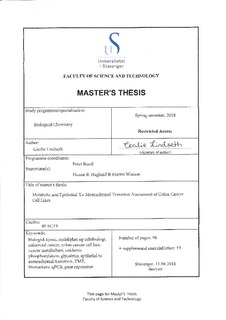| dc.contributor.advisor | Hagland, Hanne | |
| dc.contributor.author | Lindseth, Cecilie | |
| dc.date.accessioned | 2018-10-15T09:29:41Z | |
| dc.date.available | 2018-10-15T09:29:41Z | |
| dc.date.issued | 2018-06 | |
| dc.identifier.uri | http://hdl.handle.net/11250/2567974 | |
| dc.description | Master's thesis in Biological chemistry | nb_NO |
| dc.description.abstract | Background: Cancer have varying dependency on oxidative phosphorylation and
glycolysis, and cancer metastasis decreases the patient 5-year survival rate. Epithelial
to mesenchymal transition (EMT) are demonstrated to increase the chances of
metastasis. The purpose of this study was to characterize colon cancer cell lines
and colorectal cancer patient samples by qPCR. To assess how the cells were affected
in different glucose conditions and evaluate the development of cancer using
a multimarker panel.
Methods: Cell culture assay were used to check how glucose (high (4.5 g/L) and
physiological (1.0 g/L)) affected the cell viability, proliferation and invasiveness. A
multimarker panel consisting of metabolic and EMT markers were used to analyze
cell cultures that had been cultured in different glucose concentrations, and patient
samples from FFPE tissue blocks by qPCR. The multimarker panel was selected
based on previous literature and analysis on cell lines. Multiplex PCR was done
to analyze the patients DNA samples by checking if any EMAST and MSI markers
could be considered unstable.
Results: Wound healing test showed that SW948 changed morphology and formed
multilayers after applied tests, while SW1116 slowly began to heal by forming a
monolayer. GLUT1 and LDHA yielded significantly upregulation of relative gene
expression, while MCT4 yielded significantly downregulation of relative expression.
Some of the EMT markers (N-cadherin, ZEB1, TWIST1, and Vimentin) only are expressed
in the mesenchymal-like CCD-18Co cell, while E-cadherin are only expressed
in the epithelial cells (SW1116 and SW948).
Conclusions: Glucose condition were found to affect the cells relative gene expression.
GLUT1, LDHA, and MCT4 yielded significantly relative expression, and could
be used as biomarkers for understanding the cell’s metabolic profile. E-cadherin, Ncadherin,
ZEB1, TWIST1 and Vimentin could be used as biomarkers to identify the
cells phenotype, epithelial or mesenchymal. | nb_NO |
| dc.language.iso | eng | nb_NO |
| dc.publisher | University of Stavanger, Norway | nb_NO |
| dc.relation.ispartofseries | Masteroppgave/UIS-TN-IKBM/2018; | |
| dc.rights | Navngivelse 4.0 Internasjonal | * |
| dc.rights.uri | http://creativecommons.org/licenses/by/4.0/deed.no | * |
| dc.subject | colorectal cancer | nb_NO |
| dc.subject | colon cancer cell line | nb_NO |
| dc.subject | cancer metabolism | nb_NO |
| dc.subject | oxidative phosphorylation | nb_NO |
| dc.subject | glycolysis | nb_NO |
| dc.subject | epithelial to mesenchymal transition | nb_NO |
| dc.subject | EMT | nb_NO |
| dc.subject | biomarkers | nb_NO |
| dc.subject | qPCR | nb_NO |
| dc.subject | gene expression | nb_NO |
| dc.subject | biologisk kjemi | nb_NO |
| dc.subject | molekylær biologi | nb_NO |
| dc.subject | cellebiologi | nb_NO |
| dc.subject | kolorektal kreft | nb_NO |
| dc.title | Metabolic and Epithelial-to-Mesenchymal Transition Assesment of Colon Cancer Cell Lines | nb_NO |
| dc.type | Master thesis | nb_NO |
| dc.subject.nsi | VDP::Matematikk og Naturvitenskap: 400::Basale biofag: 470::Biokjemi: 476 | nb_NO |
| dc.subject.nsi | VDP::Matematikk og Naturvitenskap: 400::Kjemi: 440 | nb_NO |

